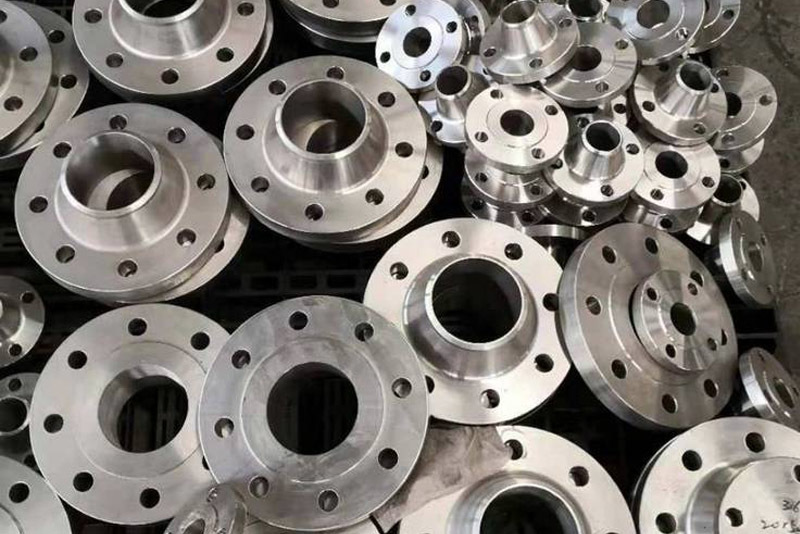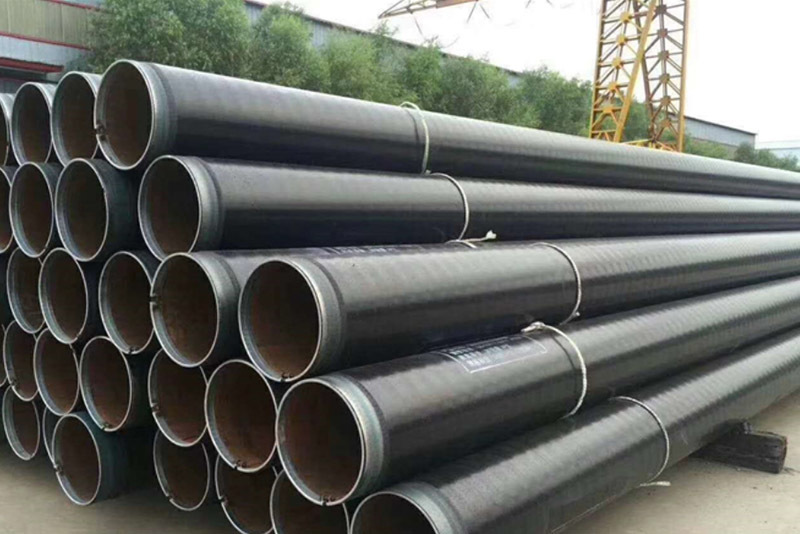2025-03-07
3PE anti-corrosion pipe production process
According to the design requirements of pipeline anti-corrosion, the anti-corrosion production of steel pipes adopts the production mode of integrated mechanical assembly line, which can be produced continuously for 24 hours under the condition of production needs. Construction personnel are divided into three shifts and shift operations are implemented. Before each process is ready and production starts, the preheating temperature of steel pipe coating and the coating thickness of each layer of anticorrosive layer shall be adjusted in sequence by the test pipe section on the production line according to the requirements for the anticorrosive thickness of the three different anticorrosive layers in pipeline anticorrosive, and production can only start after all parameters meet the requirements.
Appearance inspection of steel pipe
(1) Before processing, the appearance of the steel pipe shall be visually observed by skilled workers one by one. Whether the steel pipe has serious mechanical damage, heavy skin, cracks, dents and other defects, the unqualified steel pipe shall not be used, and the unqualified mark shall be returned. Those that have passed the acceptance can be used for construction.
⑵ If there is a flat mouth at the nozzle of the threaded pipe, it shall be repaired in a timely manner, and those that cannot be repaired shall be scrapped.
Rust removal of pipe fittings
Firstly, the steel pipe to be anticorrosive shall be transported to the upper pipe platform of the operation line by pipe grabbing machine, and the outer surface of the steel pipe shall be preheated by flame heater device to remove moisture, oil stain and impurities on the surface of the steel pipe. The heating temperature shall be controlled at 40 ℃ ~ 60 ℃, so as to improve the rust removal quality of the steel pipe surface.
⑵ All steel pipes are derusted by PW-380 steel pipe shot blasting machine. Before the steel pipes enter the shot blasting chamber, the pipe orifice plugs made of rubber pads or thick sponges are blocked at both ends of the pipe orifice of the steel pipes (for example, the pipe plugs provided by the steel pipes are blocked by their own pipe plugs), so as to prevent the steel balls in the shot blasting chamber from flying into the pipe orifice during the derusting process, reduce the loss of the steel pipes, and ensure the consumption of steel pipes, the surface of the steel pipe after shot blasting and derusting shall reach Grade Sa2.5 specified in GB/T8923-1988 Steel Surface Rust Grade and Derusting Grade before Coating, and the depth of anchor grain on the surface shall be in accordance with the instructions provided by the epoxy powder manufacturer.
(3) After the surface pretreatment, all rust, oil stains, oxide skin, etc. should be removed.
The outer surface of the steel pipe shall be inspected one by one, and the surface defects that may cause coating leakage shall be polished by appropriate methods, and the wall thickness after polishing shall not be less than the specified value. The steel pipe with defects shall be removed or repaired.
(5) For steel pipes with unqualified derusting quality, they shall be removed from the production line in time, and then return to the production line for derusting again.
Treatment of fine dust on the surface of steel pipe
⑴ After the steel pipe is derusted by shot blasting, before the epoxy powder high-voltage electrostatic spraying in the next process, the outer surface of the steel pipe is subjected to secondary treatment with a dust treatment device to remove the rust powder and dust remaining on the outer surface of the steel pipe, and the epoxy powder coating shall be applied within 4 hours. If the surface of the steel pipe exceeds 4 hours or rust returns, the surface must be pre-treated again. When the steel pipe surface is treated with fine dust, the induced draft fan on the dust removal device shall be started first, and then the dust removal motor shall be started; if the production needs to be interrupted, the stop button of the dust removal motor shall be pressed first, and then the induced draft fan shall be stopped.
⑵ Clean the dust in the cyclone vacuum cleaner regularly to avoid excessive accumulation and affect the dust removal effect.
(3) After starting the dust device, the working condition of the induced draft fan should be checked frequently.
The dust removal electrode should be regularly maintained to ensure normal operation.
(5) During anti-corrosion production, the dust treatment on the surface of the steel pipe shall be checked at least once per hour.
Steel pipe preheating
(1) After the dust treatment of steel pipe, before the epoxy powder coating, should be pre-heat treatment, the use of KGPS-750uw constant power medium frequency machine to the steel pipe heating, preheating temperature must meet the requirements of epoxy powder coating temperature, but the maximum shall not exceed 275 ℃.
⑵ Check the water level of the medium frequency circulating pool to ensure that the water volume is at least 2.5~3 cubic meters. Start the intermediate frequency circulating water pump and check whether all pipelines of circulating water are leaking. Only when everything is normal in the circulating water pipeline can the intermediate frequency device be started.
⑶ According to the feeding speed of steel pipes with different diameters and the predetermined heating temperature, the output power value of medium frequency heating is determined by adjusting the production line with the experimental tube.
The use of advanced temperature measuring instruments to measure the temperature of the steel pipe preheating, improve the accuracy of the measurement, to ensure that the steel pipe powder coating, steel pipe preheating temperature in the range of powder coating manufacturers recommended.
(5) During anti-corrosion production, measure and record at least once per hour to determine the preheating temperature of the steel pipe during powder coating.
Epoxy powder roll coating or spray coating
Since the process of hot rolling coating is quite different from that of hot spraying, it will not be described in detail here.
Adhesive coated with polyethylene tape winding
(1) The coating of the adhesive must be carried out during the gelation of the epoxy powder.
⑵ When the lateral winding process is adopted, it shall be ensured that the polyethylene of the overlapping part and the polyethylene on both sides of the weld are completely rolled and compacted, and the surface of the polyethylene layer shall be prevented from being crushed.
circulating water cooling
After the steel pipe anticorrosive coating is finished, it shall be cooled and fixed in time. Circulating water casting chamber can be used to cool the anticorrosive coating surface layer of the steel pipe, and the cooling shall be carried out by sections.
⑴ Before production, start the circulating water pump motor of the casting chamber.
⑵ Adjust the switch of each valve of the cooling water pipe to control the size of the cooling water, so as to avoid the impact on the anti-corrosion coating caused by the excessive water flow and affect the appearance and forming quality of the coating.
(3) Before the steel pipe enters the first group of transmission wheels in the casting chamber, the first cooling water is used for cooling. In this way, the anti-corrosion coating on the surface of the steel pipe is rolled onto the first group of rubber wheels, and the anti-corrosion coating will not be damaged and remain intact.
(4) According to the size of the pipe diameter and the difference in ambient temperature, take 2~4 sections of cooling water for section by section cooling, the cooling temperature of the steel pipe is not higher than 60 ℃, and ensure that the fusion bonded epoxy coating is completely solidified.
The appearance of the coating should be smooth, uniform color, no bubbles, cracking and shrinkage, allowing a slight orange peel pattern, coating thickness should meet the design requirements.
For each continuous production batch, at least the thickness of the anticorrosive coating of the first, fifth and tenth steel pipes shall be checked, and then at least one of every ten pipes shall be sampled.
If the owner has requirements, it shall be implemented according to the owner's requirements.
Cutting head
After the anti-corrosion layer of the steel pipe is cooled by cooling water, the reserved length of the pipe end is 100-120mm,
Grinding pipe end retention head
(1) The end face of the polyethylene layer shall be chamfered at not more than 30 degrees, and the epoxy powder coating of not more than 20mm can be retained outside the end of the polyethylene layer. The anti-corrosion coating at the end of the anti-corrosion pipe shall be prevented from peeling off or lifting.
(2) The pipe end shall be treated with electric wire brush, and the operation shall be carried out in 2-3 sections to meet the requirements of the standard.
(3) The working surface of the wire brush used to grind the chamfer of the anticorrosive layer at the end of the pipe shall be flat and free of convexity and concavity.
Next:
Tel / WhatsApp:
E-mail:











